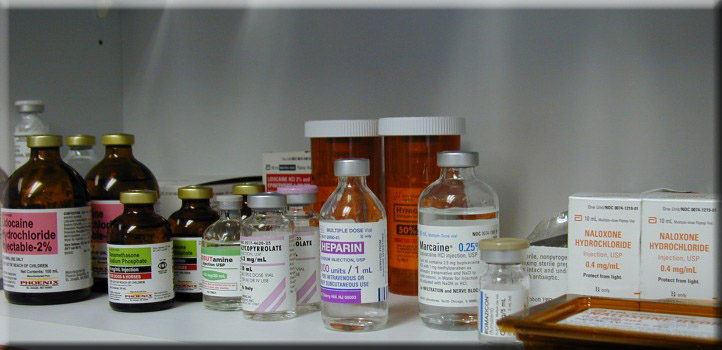 |
Veterinary Anesthesia & Analgesia Support Group |
| Practical Information for the Compassionate Veterinary Practitioner |
|
| HOME |
 |
||
|
|
||
| Alphabetical Drug Summaries | ||
| Dr. Bob Stein | ||
1) HALOTHANE
a) Classification
i) A halogenated hydrocarbon b) General Information
i) A relatively fast acting inhalant anesthetic agent ii) MAC (1) Dogs - 0.76% (2) Cats - 0.82% c) Advantages/Recommended use
i) A good choice for general anesthetic use ii) May facilitate bronchodilator for respiratory disease patients d) Cautionary Information
i) Undergoes significant hepatic metabolism (1) Less well suited to patients with hepatic disease (2) Approximately 12% of absorbed drug is metabolized by liver ii) More arrhythmogenic than isoflurane (1) Avoid if cardiac trauma is suspected iii) More likely to trigger malignant hyperthermia than isoflurane iv) Vasodilation can create increased intracranial pressure v) Preservatives in the product create residue within the vaporizers (1) Yearly vaporizer maintenance is recommended e) Dosage Information
i) Mask Induction (1) Not recommended ii) Induction following injectable agent (1) Initiate flow rates of 1.0 to 1.5 liter per minute at 2.5 % - 4.0 % (a) Reduce percentage as indicated by patients response iii) Maintenance – Moderately low flow use (1) Once stable, reduce oxygen flow to 500 ml to 1 liter (a) The reservoir bag must remain reasonably full
(i) If not, the flow rate must be increased and the machine must be examined for leaks at the earliest possible convenience (2) Remember that prior to surgical stimulation, a patient may appear adequately anesthetized only to show a dramatic response to stimulation (a) An experienced anesthetist should be able to anticipate and minimize this event (3) Effective analgesic & sedative premeds will significantly reduce the level of inhalant agent necessary for maintenance of a surgical plane of anesthesia f) Cost
i) Low 2) HEPARIN
a) Classification
i) Anticoagulant affecting both intrinsic and extrinsic pathways b) General Information
i) Does not cross placenta ii) Protamine is the direct reversal agent c) Advantages/Recommended use
i) To produce heparinized saline solutions ii) Treatment of DIC iii) Treatment of thromboembolic disease d) Cautionary Information
i) Do not give IM (1) Can cause hematoma formation (2) Should be given IV or SC only e) Dosage Information
i) Heparinized saline - 1 ml heparin per liter of 0.9% NaCl (1) Clearly identify bag contents and dating using a fluorescent orange label f) Cost
i) Low
a) Classification
i) Pure mu agonist (1) Class II b) General Information i) Duration of effect is 4 to 6 hours ii) Considered to have similar overall properties when compared to oxymorphone although less potent c) Advantages/Recommended use
i) General premed for anesthetic candidates in all categories ii) Generally less panting than oxymorphone iii) Unlike Morphine, should not cause transient hypotension (1) IV use is not associated with histamine release d) Cautionary Information
i) Bradycardia is common ii) Vomiting is common after IM administration iii) There is moderate sedative synergism between hydromorphone and acepromazine in the dog (1) Acepromazine doses should be kept at the lower end of the dose range iv) There is a tendency for cats to be agitated unless higher Acepromazine doses are used e) Dosage Information
i) Dog – 0.1 to 0.4 mg/kg (0.05 - 0.20 mg/lb) IV, IM (1) Generally 0.1 to 0.2 mg/kg (0.05 to 0.10 mg/lb) ii) Cats – 0.05 to 0.2 mg/kg (0.025 - 0.10 mg/lb) IV, IM (1) Generally 0.05 to 0.1 mg/kg (0.025 to 0.05 mg/lb) iii) Induction (1) IV induction – most useful for dogs (a) See "Diazepam & a pure mu agonist Opioid" section under Induction Protocols for details iv) Maintenance (2) IV maintenance – most useful for dogs (a) See "Diazepam & a pure mu agonist Opioid" section under Maintenance Protocols for details v) Epidural dose (1) 0.03 to 0.10 mg/kg (0.015 to 0.05 mg/lb) f) Cost
i) Low |
||
| Return to top of page | ||
| Questions or problems regarding this web site should be directed to DRSTEIN@VASG.ORG . Copyright © 2003 ASAH. All rights reserved. Last modified: April 13, 2014 . |
||